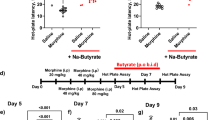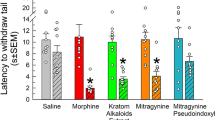Abstract
Conditioned taste aversions (CTAs) develop if toxicosis is induced after an animal eats or drinks. Usually, if a second drug is administered after consumption and prior to the toxin, it either adds to the CTA produced by the toxin or else has no noticeable effect. However, glucocorticoids (dexamethasone, cortisol, methylprednisolone, and prednisolone) attenuate CTAs produced by cyclophosphamide. Dexamethasone was tested most extensively and is also effective against CTAs produced by carmustine, cisplatin, copper sulfate, cytarabine, dactinomycin, doxorubicin, lithium chloride, and mechlorethamine. Delta-9 THC, domperidone, haloperidol, metoclopramide, and scopolamine were ineffective against CTAs produced by cyclophosphamide, although they are used medically for palliative purposes. Prochlorperazine attenuated CTAs but to a much smaller extent than the glucocorticoids. These results are interpreted as cross-validation of recent reports that glucocorticoids alleviate clinically observed distress produced by cancer chemotherapies.
Similar content being viewed by others
References
Aapro MS, Plezia PM, Alberts DS, Graham V, Jones SE, Surwit EA, Moone TE (1984) Double-blind crossover study of the antiemetic efficacy of high-dose dexamethasone versus high-dose metoclopramide. J Clin Oncol 2:466–471
Allan SG, Cornblett MA, Warrington PS, Golland IM, Leonard RCF, Symth JF (1984) Dexamethasone and high dose metoclopramide: efficacy in controlling cisplatin induced nausea and vomiting. Br Med J 289:878–879
Baldessarini RJ (1980) Drugs and the treatment of psychiatric disorders. In: Gilman AG, Goodman LS (eds) Goodman and Gilman's the pharmacological basis of therapeutics, 6th edn. MacMillan, New York, pp 391–447
Boland FJ, Mellor CS, Revusky S (1978) Chemical aversion treatment of alcoholism: Lithium as the aversive agent. Behav Res Ther 16:401–409
Bozarth MA, Wise RA (1984) Anatomically distinct opiate receptor fields mediate reward and physical dependence. Science 224:516–517
Cairnie AB, Leach KE (1982) Dexamethasone: a potent blocker of radiation induced taste aversions in rats. Pharmacol Biochem Behav 17:305–312
Cassileth PA, Luck EJ, Torri S, DiNubile N, Gerson SL (1983) Antimetic efficacy of dexamethasone therapy in patients receiving chemotherapy. Arch Int Med 143:1347–1349
Claman HN (1972) Corticosteroids and lymphoid cells. N Engl J Med 287:388–397
Cronin C, Sallan SE (1983) Delta-9-THC and marijuana. In: Laszlo J (ed) Antiemetics and cancer chemotherapy. Williams and Wilkins, Baltimore, pp 108–115
Domjan M, Best MR (1977) Paradoxical effects of proximal unconditioned stimulus pre-exposure: Interference with and conditioning of taste aversion. J Exp Psychol [Anim Behav Proc] 3:310–321
Franz DN (1980) Central nervous system stimulants. In: Gilman AG, Goodman LS, Gilman A (eds) Goodman and Gilman's the pharmacological basis of therapeutics, 6th edn. MacMillan, New York, pp 585–591
Gamzu E, Vincent G, Boff E (1985) A pharmacological perspective of drugs used in establishing conditioned food aversions. Ann NY Acad Sci 443:231–249
Garcia J, Lassiter PS, Bermudez-Rattoni F, Deems DA (1985) A general theory of aversion learning. Ann NY Acad Sci 443:8–21
Gerstner HB (1960) Reaction to short term radiation in man. Annu Rev Med 11:289–302
Goudie AJ, Stolerman IP, Demellweek C, D'Mello GD (1982) Does conditional nausea mediate drug-induced conditioned taste aversion? Psychopharmacology 78:277–281
Gralla RJ (1983) Antiemetic studies with metoclopramide in chemotherapy induced nausea and vomiting. In: Laszlo J (ed) Antiemetics and cancer chemotherapy. Williams and Wilkins, Baltimore, pp 129–141
Grant V (1987) Do conditioned taste aversions result from activation of emetic mechanisms? Psychopharmacology 93:405–415
Haid M (1981) Steroid antiemesis may be harmful. N Engl J Med 304:1237
Haynes RC, Jr, Murad F (1980) Adrenocorticotropic hormone: adrenocortical steroids and synthetic analogs: inhibitors of adrenocortical steroid biosynthesis. In: Gilman AG, Goodman LS (eds) Goodman and Gilman's the pharmacological basis of therapeutics 6th edn. MacMillan, New York, pp 1466–1496
Hennessy JW, Smotherman WP, Levine S (1976) Conditioned taste aversion and the pituitary adrenal system. Behav Biol 16:413–424
Hennessy JW, Smotherman WP, Levine S (1980) Investigation into the nature of the dexamethasone and ACTH effects upon learned taste aversion. Physiol Behav 24:645–649
Kris MG, Gralla RJ, Tyson LB, Clark RA, Kelsen DP, Reilly LK, Bosl J, Kalman LA (1985) Improved control of cisplatin-induced emesis with high-dose metoclopramide and with combinations of dexamethasone, and diphenhydramine. Cancer 55:527–534
Lett BT (1983) Pavlovian drug-sickness pairings result in the conditioning of an antisickness response. Behav Neurosci 97:779–784
Lett BT (1985) The painlike effect of gallamine and naloxone differ from sickness induced by lithium. Behav Neurosci 99:145–150
Markham M, Sheidler VS, Ettinger DS, Quaskey SA, Mellits ED (1984) Antiemetic efficacy of dexamethasone. N Engl J Med 311:549–552
McCarthy LE, Borison HL (1983) Animal models for predicting antiemetic drug activity. In: Laszlo J (ed) Antiemetics and cancer chemotherapy. Williams and Wilkins, Baltimore, pp 21–33
Munck A, Guyre PM, Holbrook NJ (1984) Physiological functions of glucocorticoids in stress and their relation to pharmacological actions. Endocrinol Rev 5:25–44
Nachman M, Hartley PL (1975) Role of illness in producing learned taste aversions in rats: a comparison of several rodenticides. J Comp Physiol Psychol 89:1010–1018
Revusky S, Garcia J (1970) Learned associations over long delays. In: Bower G, Spence J (eds) Psychology of learning and motivation: Advances in research and theory 4:1–83
Revusky S, Harding RK (1986) Pairing pentobarbital with one toxin causes it to attenuate taste aversions produced by a different toxin: implications for conditioned antisickness theory. Behav Neurosci 100:685–694
Revusky S, Coombes S, Pohl RW (1982) Drug states as discriminative stimuli in a flavor-aversion learning experiment. J Comp Physiol Psychol 96:200–211
Rusiniak KW, Garcia J, Hankins WG (1976) Bait shyness: Avoidance of the taste without escape from the illness in rats. J Comp Physiol Psychol 96:200–211
Selye H (1956) The stress of life. McGraw-Hill, New York
Smotherman WP (1985) Glucocorticoid and other hormone substrates of conditioned taste aversions. Ann NY Acad Sci 443:126–144
Strum SB, McDermed JE, Lipioni DF (1985) High-dose intravenous metoclopramide versus combination high-dose metoclopramide and intravenous dexamethasone in preventing cisplatin-induced nausea and emesis: a single blind crossover of antiemetic efficacy. J Clin Oncol 3:245–251
Van der Kooy D, Swerdlow NR, Koob GF (1983) Paradoxical reinforcing properties of apomorphine: effects of nucleus accumbens and area postrema lesions. Brain Res 259:111–118
Author information
Authors and Affiliations
Rights and permissions
About this article
Cite this article
Revusky, S., Martin, G.M. Glucocorticoids attenuate taste aversions produced by toxins in rats. Psychopharmacology 96, 400–407 (1988). https://doi.org/10.1007/BF00216070
Received:
Revised:
Issue Date:
DOI: https://doi.org/10.1007/BF00216070




